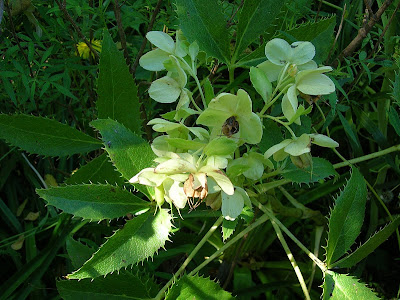
Our first visit of the day was to Domaine d'Orvès in La Valette. The house was built in 1695 and was in fact a farmhouse when the Pierre & Henriette Duval, the parents of the present owner "Françoise Darlington", bought it in 1925. They restored and improved it to become a more substantial property. During World War II the Nazi's occupied the house and felled all the trees, just the Plane trees near the entrance of the house were saved. In total they cut down 1200 trees. After the war the Duvals' started from scratch, planting trees and shrubs, restoring the house to it's former glory. Their daughter inherited the property in 1993 and has continued in their foot steps.
The first part of our visit was to a water lily pond.
Quite lovely.
We continued our visit to the formal part of the garden.
An arched walkway made by pleached fig trees, gave some welcome shade.
On either side of the arched walkway, masses of irises bordered the path, behind the irises, shrubs (most with grey tinted leaves) were planted to complete the border.
Françoise Darlington had some urgent matters to see to, so her daughter-in-law took over and took us on a walk up the restanques and grounds above the house.
On each level there were interesting plants to admire. I've tried to name as many as I could remember and find. To discover new varieties of plants, shrubs or trees makes these garden visits so enjoyable:
Abutilon megapotanicum (You might remember it from Nathalie Rigg's garden).
Acacia alata
Acacia karroo - a Mimosa with very sharp long thorns.
Acanthus mollis.
Acanthus spinosa.
Actinidia 'deliciosa' - Kiwi fruit.
Anchusa azurea - bright blue flowers growing near to the "La Mortola" rose.
Arbutus glandulosa - the interesting part of this tree is its bark, cinnemon coloured, peeling in the summer to a pistachio green colour.
Arbutus menziesii - similar to the A. glandulosa except that the bark does not turn green.
Arundo Donax - Giant Reed.
Buddleja officinalis - A winter flowering/early spring flowering Buddleja.
Bulbinella hookeri - Lovely orange/yellow flowering bulb.
Callistemon citrinus - Bottlebrush.
Callistemon "Mauve Mist"- pink flowering Bottlebrush.
Cerotostigma - It was not yet in flower, but planted on the formal area of the garden, mixed with poppies and other wild flowers.
Cistus x purpureus.
Convolvulus mauritanicum.
Cyperus papyrus - Papyrus.
Duranta repens - Golden dewdrop/Sky flower, with pendant blue flowers, yellow berries follow.
Echium candicans - family of Echium vulgare (Viper's Bugloss) but much taller and fuller.
Eleagnus angustifolia 'Quicksilver'.
Equisetum arvensis (Horsetail) - awful weed to get rid off, once you have it in your garden but quite a useful herb, a poultice can be applied externally to aid the healing of wounds, sores and ulcers; the tisane is effective as a mouthwash in aphthous ulcers or gingivitis, and can be used as a douche in leucorrhoea or menorrhagia. It was growing at the edge of the pond.
Erigeron karvinskianus 'Profusion', whole beds on the restanque was filled with the small daisy like flowers.
Eriobotrya japonica - Loquat.
Eucalyptus citriodora - essential oil is made out of the leaves. A curious thing is when you touch the trunk of the tree it is cold to the touch.
Grevillea robusta - Silky Oak, upright/conical tree with yellow/orange Bottlebrush like flowers.
Helleboris argutifolius/corsicus - Corsican Hellebore.
Hylocereus undatus - fast growing, epiphytic or climbing cactus - Hanna
Hymenosporum flavum - Australian frangipani tree, very fragrant yellow flowers, related to the Pittosporum.
Iris pseudacorus - Yellow Iris on edge of the pond.
Iris "Shelford Giant" - Very tall white Iris growing along the path not far from Rosa "La Mortola".
Lychnis coronaria - Rose Campion.
Magnolia delavayi - an evergreen Magnolia, flowering in the summer.
Melaleuca densa - related to the Bottlebrush
Melia azedarach (Indian Bead Tree) - very large specimen in flower.
Meliathus major.
Pelargonium - many different varieties, growing in the dappled shade.
Ptilostemon gnaphaloides.
Rosa La Mortola - fantastic single white climbing rose, growing over one of the buildings.
Salvia mellifera.
Sollya heterophylla - Bluebell creeper, lovely small blue bell flowers, near the swimming pool.
Tetrapanax papyriferus - Rice Paper Plant.
Zantedeschia aethiopica "Green Goddess", looks like an Arum.
After our visit we had our usual picnic lunch just in front of the house on the terrace shaded by the plane trees. The setting was lovely.
The afternoon visit was to the Succulent Garden of Mr. & Mrs. Navarro in La Garde. This garden is so amazing, I can recommend anyone reading this article to visit it.
The Navarro's started the garden in 1971 and since then they've built up collections of Aeonium, Agave, Aloe, other Succulents and Cacti, too many to mention in this blog. They have 5 greenhouses were the more tropical Cacti and Succulents are stored, the winter they store 1800 pots in the various greenhouses, during the summer these pots are outside.
This garden is a living museum for Cacti & Succulents. In the summer they start watering at 05.00 hrs to finish watering at 10.00 hrs. They're both devoted to their plants and it shows.
Beside the Cacti & Succulents they've introduced several interesting shrubs and trees into the garden.
The amount of plants in the garden is so immense that it is impossible to mention them all:
Aloe Vera - with the yellow spike and Aloe ferox - with the orange spike.
Dichondra - Dichondra seed alternative lawn, seed available from seedland.com - Hanna
Ferula communis - Giant Fennel.
Hoodia juttea - flowers have a very unpleasant smell.
Lagunaria pattersonii - Cow Itch Tree.
Lonicera x brownii "Dropmne Scarlet" - Red Honeysuckle
Otata acuminata artecorum - Mexican Weeping Bamboo.
Phytolacca dioica - Their tree is not so large yet!
Podophyllum 'Kaleidoscope'.
Senna artemisioides.
Teucrium subspinosum.
Thespesia peruvia - yellow Hisbiscus like flowers.
We finished the visit with a very welcoming cold drink on their terrace.
Bibliography: RHS A-Z Book, Elisabeth Boutevin: Photographs


















































